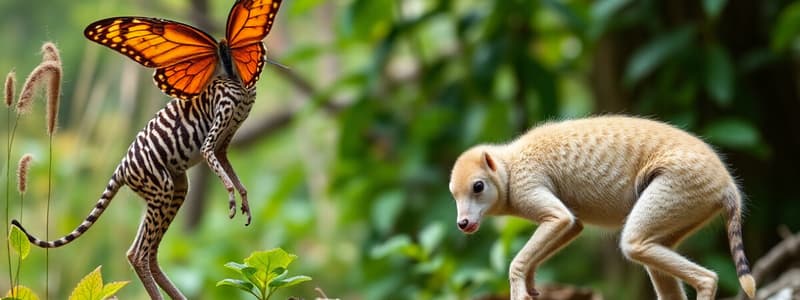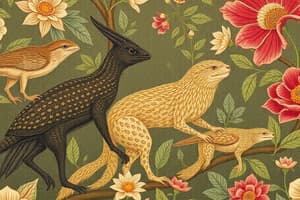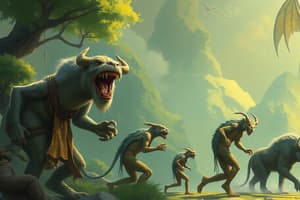Podcast
Questions and Answers
Which of the following best exemplifies overproduction, a key component of Darwin's theory of natural selection?
Which of the following best exemplifies overproduction, a key component of Darwin's theory of natural selection?
- A population of fish adapting to increasingly polluted waters by developing resistance to toxins.
- A bird species laying more eggs than can be sustained by the environment's resources. (correct)
- A group of mammals migrating to a region with fewer predators.
- A plant species evolving vibrant flowers to attract more pollinators.
In the context of natural selection, what is the most accurate definition of 'fitness'?
In the context of natural selection, what is the most accurate definition of 'fitness'?
- An organism's ability to survive, reproduce, and pass on its genes to the next generation. (correct)
- The physical strength and speed of an individual within a population.
- The degree to which an organism's traits match the ideal form for its species.
- A measure of an organism's genetic diversity compared to others in its population.
How does natural selection lead to adaptation in a population over time?
How does natural selection lead to adaptation in a population over time?
- By favoring the survival and reproduction of individuals with advantageous traits. (correct)
- By ensuring that all individuals in a population develop the same beneficial traits.
- By randomly introducing new traits into the population's gene pool.
- By directly changing the genetic makeup of individuals in response to environmental pressures.
What role did the industrial revolution play in the natural selection of dark-colored peppered moths?
What role did the industrial revolution play in the natural selection of dark-colored peppered moths?
What is a 'selection pressure' and how does it influence natural selection?
What is a 'selection pressure' and how does it influence natural selection?
In the example of the peppered moths, what was the primary selection pressure that influenced the shift in moth coloration?
In the example of the peppered moths, what was the primary selection pressure that influenced the shift in moth coloration?
How did Darwin's understanding of inheritance contribute to his theory of natural selection, even though genetics was not well understood at the time?
How did Darwin's understanding of inheritance contribute to his theory of natural selection, even though genetics was not well understood at the time?
Camels possess long eyelashes and closable nostrils. How do these features support their survival in the desert?
Camels possess long eyelashes and closable nostrils. How do these features support their survival in the desert?
According to Darwin's theory, why do variations among individuals in a population matter for natural selection?
According to Darwin's theory, why do variations among individuals in a population matter for natural selection?
In what way does the giraffe's long neck represent an adaptation resulting from natural selection?
In what way does the giraffe's long neck represent an adaptation resulting from natural selection?
How does the concept of 'evolution' relate to 'natural selection'?
How does the concept of 'evolution' relate to 'natural selection'?
Which of the following scenarios best illustrates the process of adaptation?
Which of the following scenarios best illustrates the process of adaptation?
If a population of insects is exposed to a new pesticide, which of the following outcomes would best demonstrate natural selection?
If a population of insects is exposed to a new pesticide, which of the following outcomes would best demonstrate natural selection?
Which of the following is an example of an adaptive feature?
Which of the following is an example of an adaptive feature?
A population of rabbits is introduced to a new environment with different vegetation. Which scenario would demonstrate natural selection?
A population of rabbits is introduced to a new environment with different vegetation. Which scenario would demonstrate natural selection?
Flashcards
Evolution
Evolution
Changes in the adaptive features of populations over time.
Natural Selection
Natural Selection
Individuals better suited to their environment are more likely to survive and reproduce.
Adaptation
Adaptation
The process by which populations become better suited to their environment over generations.
Natural Variation
Natural Variation
Signup and view all the flashcards
Overproduction
Overproduction
Signup and view all the flashcards
Struggle for Survival
Struggle for Survival
Signup and view all the flashcards
Survival advantage
Survival advantage
Signup and view all the flashcards
Adaptive Traits Evolving
Adaptive Traits Evolving
Signup and view all the flashcards
Selection Pressure
Selection Pressure
Signup and view all the flashcards
Adaptive Feature
Adaptive Feature
Signup and view all the flashcards
Fitness
Fitness
Signup and view all the flashcards
Phenotype
Phenotype
Signup and view all the flashcards
Peppered Moth - Pre-Industrial
Peppered Moth - Pre-Industrial
Signup and view all the flashcards
Peppered Moth - Post-Industrial
Peppered Moth - Post-Industrial
Signup and view all the flashcards
Industrial Revolution Impact
Industrial Revolution Impact
Signup and view all the flashcards
Study Notes
- Camels survive in desert environments due to long, bushy eyelashes and closable nostrils.
- Giraffes can reach the leaves of tall trees due to their long legs and necks.
The Theory of Natural Selection
- Evolution is the change in the adaptive features of populations over time
- Natural selection is the process by which the fittest individuals are more likely to survive and reproduce.
- Adaptation is the process by which populations become more suited to their environment over generations.
- Charles Darwin’s theory of evolution by natural selection was published in 1859 in On the Origin of Species.
- Variations exist naturally among individuals within a population
- Some trait forms make individuals more or less fit to the environment
- More offspring are generally produced than the environment can support, referred to as overproduction.
- Due to limited resources, organisms compete to survive.
- Individuals adapted to their environment have a survival advantage.
- Well-adapted organisms are more likely to survive, reproduce, and pass on adaptive features.
- Less adapted individuals are less likely to survive and may disappear from the population.
- Evolution results in traits that suit individuals to their environment becoming common.
- Traits with little survival advantage become less common, potentially leading to new species.
- Natural selection: factors in an organism's environment may favor or disfavor specific trait forms.
- Changing environmental conditions can cause species to change and evolve over time
- Inherited adaptive features make an organism more fit, encoded by genes
- Alleles for advantageous phenotypes are frequently passed from parents to offspring versus less advantageous phenotypes.
Peppered Moth Example
- Peppered moths are a common example of natural selection.
- Before the industrial revolution in Great Britain, light-colored speckled moths were more common as birds could not see them on lichen-covered tree trunks.
- Birds easily spotted dark-colored ones.
- Predation by birds is an example of selection pressure, which leads to the selection of a trait that improves an organism’s survival.
- Speckled wings gave the moths a survival advantage over dark-colored wings.
- The industrial revolution caused dark-colored moths to become more numerous in industrial areas
- Local industry polluted woodlands with soot, killing lichens
- Tree trunks turned dark, so dark-colored moths blended in while speckled moths became more easily spotted by birds.
- Predation by birds caused moths with dark-colored wings to have a survival advantage and become more common
- The dark-colored moths reproduced at higher rates and eventually outnumbered speckled moths.
- The allele coding for dark-colored wings became more frequent because it produced an advantageous phenotype.
Studying That Suits You
Use AI to generate personalized quizzes and flashcards to suit your learning preferences.
Description
Explore natural selection: how environmental pressures favor certain traits, leading to adaptation and evolution over generations. Understand Darwin's concepts of variation, overproduction, and competition. Discover how advantageous traits enhance survival and reproduction.




